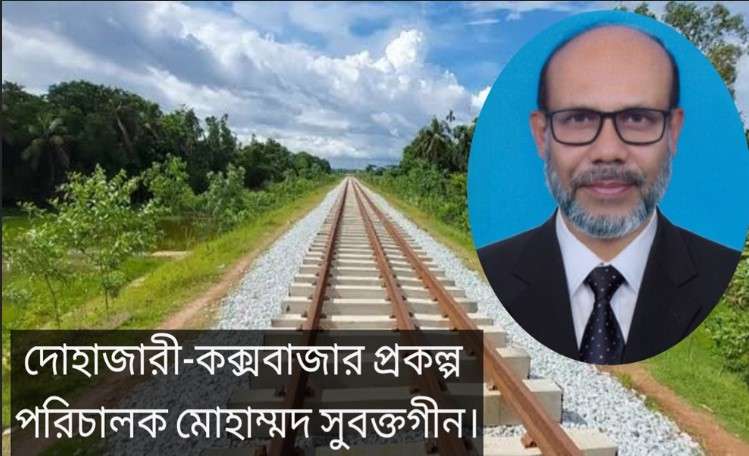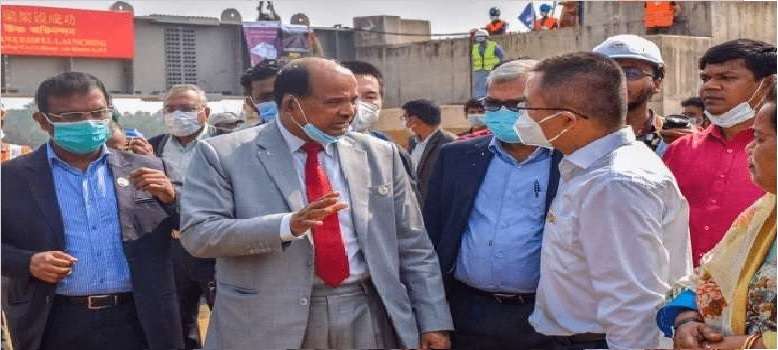The project to build a new railway line from Dohazari in Chittagong to Cox’s Bazar and from Ramu to Ghundhum on the Myanmar border was approved in 2010. The cost of this project, which is part of the government’s fast track, has been set at 18,340 million taka. In the meantime, the century-old dream of a railway is now a reality. The construction of the railway line from Dohazari in Chittagong to Cox’s Bazar has been completed.
A 101-kilometer single-line dual-gauge railway has been constructed to the tourist city of Cox’s Bazar. The Bangladesh government’s fast track project has connected the entire country to Cox’s Bazar by rail for the first time. Project Director Mohammad Subaktagin spoke about various aspects of this great undertaking.
Why is the Chittagong-Cox’s Bazar railway different from other railways in the country?
First of all, this railway line connects a new district (Cox’s Bazar). This is a big project to connect a tourist city. In our country, illegal rail crossings are built everywhere and vehicles or people cross. This also increases the risk of accidents. Due to the lack of adequate gatemen and the lack of use of modern technology, most of the railway accidents are centered on rail crossings. To overcome this crisis, an underpass has been built on a large part of the newly built Dohazari-Cox’s Bazar 100-kilometer railway line. That is, the risk of accidents will be reduced to zero by running trains through tunnels. Moreover, since there is no need to appoint gatekeepers at these crossings, the railway will also save a huge amount of money. For these reasons, the railway line is different from other routes.
What challenges did you face in building the railway?
This railway has been constructed through a reserved forest area. As a result, we had to cut down several trees in the forest. In addition, we have to identify the elephant’s movement path and plant seven lakh trees on their movement path. In the meantime, we have planted almost all the trees. Many trees have now grown. In addition, a few days ago, we are conducting salt test tests on the soil of the railway track that was removed due to the recent floods in Lohagara and Chakaria. According to the report, we have also started our work by taking quick measures and repairing them. During the COVID-19, we had to face various challenges in the construction of the railway track. However, we have been able to show success by working on the challenges.
How has work been done to prevent damage to protected forests and what measures has the Railways taken to control elephant movement?
The railway line had to be built from Dohazari to Cox’s Bazar through various protected forests and mountains. From the beginning of the project, we have worked keeping in mind that there is no damage to the environment. In addition, underpasses and overpasses have been built so that wild elephants and other wildlife that are present in these protected forests or mountains can freely roam from one side of the forest to the other. Again, the type of trees that elephants eat have been planted on their path; the way we have built the underpass or overpass so that elephants travel in that direction. The railway and road have been built by monitoring CCTV cameras for a long time in the deep jungle. To our knowledge, such an underpass or overpass has not been built anywhere in Asia before just for elephants.
Several salt lakes and underpasses, overpasses, have been built in this project to ensure the smooth movement of wild animals, especially elephants. Along with this, the safety of other animals has also been kept in mind. In addition, extensive afforestation initiatives have been taken on both sides of the railway line.
What is the purpose of building a state-of-the-art railway station in Cox’s Bazar?
Cox’s Bazar Railway Station has been built in a very modern and creative way. Other railway stations in the country are either single or double storey, where only operational work is done or some toll booths or shops are built. In addition to operational work at Cox’s Bazar Railway Station, the six-storey building has been arranged separately for commercial work, starting from elevators, escalators, food courts, department stores, shopping malls, residential, lockers for passengers. That is why it is the iconic railway station of the country.
What role do you think the railway will play in socio-economic development and trade?
If the deep sea port is opened in Matarbari, this railway will play a major role in the country’s goods transport. Another railway line will be built through a bypass from Chakaria. Although most of the goods transport in the country is mainly by road, the communication between this region and other regions will become the easiest and most popular by rail. Because the road network in this region has not been developed in a modern way, due to which the region will become a business hub for transporting goods by train. This will also increase the demand for freight trains day by day. Moreover, since the fare of the railway is low and the travel time is shorter than that of the road, passengers will also prefer trains. Initially, the train will run at a speed of 50-60 km on this route, the current speed is 80 km, but later the speed limit will be increased. Then, Chittagong-Cox’s Bazar can be traveled in 2 hours.
News Source Link : Click Here





